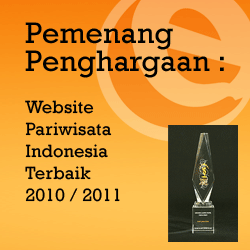General Condition

The volcanic cone of Ijen dominates the landscape at the eastern end of Java. Crater of Ijen is filled by a spectacular turquoise blue lake, its surface streaked in wind-blown patterns of yellow sulphur. Kawah Ijen is the world's largest highly acidic lake and is the site of a labor-intensive sulfur mining operation in which sulfur-laden baskets are hand-carried from the crater floor. Many other post-caldera cones and craters are located within the caldera or along its rim. The largest concentration of post-caldera cones forms an E-W-trending zone across the southern side of the caldera. Coffee plantations cover much of the Ijen caldera floor, and tourists are drawn to its waterfalls, hot springs, and dramatic volcanic scenery.
To Ijen Crater :
Is a nature wonder that can be reached from Bondowos. The Crater has 5,466 acres wide on the elevation of 2,386 m above sea level. During dry season from April through October the temperature drops to 2 - 18 Centigrade. Down to the crater sulphur mining can be found. Packed to this journey. A plantation tour to Perkebunan Nusantara XII in Jampit can be arrange. You will get a new experience enjoying an arabica coffe plantation tour. A Very fresh air on the elevation of 900 m above sea level will make your tour as unforgettable trip.
Anyone travelling on a clear day across the narrow strait separating East Java and Bali will almost certainly be impressed by the two towering mountain peaks dominating the Javanese horizon. These are the summits of Mt Merapi and the crater rim of Ijen, just two points lying on the edge of a vast caldera, which at its widest point is some 20 km in diameter.
The Ijen plateau lies in the centre of the Ijen Merapi-Maelang Reserve, which extends over much of the mountainous region directly west of Banyuwangi and borders on the Baluran National Park in the north east. As at Bromo, the caldera is best viewed from the air. Fortunately, almost all commercial flights operating between Denpasar and Surabaya, Yogyakarta or Jakarta usually fly, if not directly over, then close by the Ijen plateau, where the seemingly luminous blue/green crater lake forms an unmistakeable landmark. The lake lies at the far eastern end of the plateau and is without doubt among the most impressive of East Java's natural wonders. Despite the long and arduous journey along punishing roads (a four wheel drive vehicle is essential), the trip to Ijen is more than worth the effort and is sure to prove an unforgettable experience for anyone who makes it to the end of the trail.
Kawah (crater) Ijen can be reached from either the east or the west. The latter is the more popular approach, since the climb from the road's end to the edge of the lake is only one and a half hours. The road from Banyuwangi, on the other hand, involves a six to seven hour trek from the village of Licin. The western route starts from Wonosari, a few kilometres outside Bondowoso, the town famous for its bull fights. A narrow road, full of potholes, runs east and up from Wonosari, rapidly deteriorating into bone shaking loose rock and gravel. Seemingly endless hairpin bends ascend into forests of casuarina (cemara) trees, giving way to pine forests and coffee plantations. The temperature drops. At night, near the crater rim, it can fall to about 5 degrees celsius.
The road ends at Jampit, where very basic shelter is available. It is also possible to sleep in the old vulcanology station further up the hill, now used by sulphur collectors, but permission must be obtained in advance.









